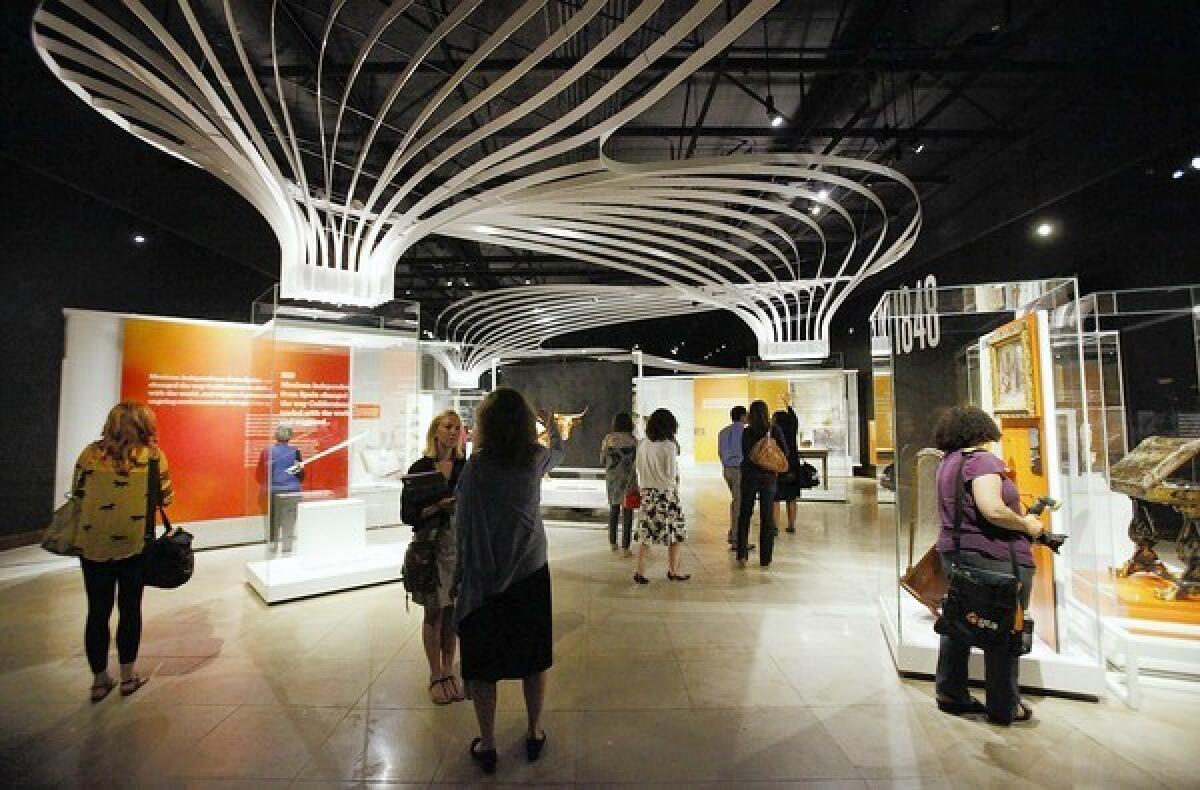‘Becoming Los Angeles’ explains L.A.’s 240-year journey

The golden hills of California have not always been so golden.
A new exhibit at the Natural History Museum of Los Angeles County offers explanations for the golden hills of California (fertilized by cow droppings), the evolution of diversity in Los Angeles (fueled by the Gold Rush and 44 Mexican settlers) and the reason Hollywood became the center of the entertainment industry (cheap land and diverse backdrops).
The museum opened “Becoming Los Angeles” on Sunday, its new permanent exhibit, fecal matter stories and all, geared toward explaining the development of the city from environmental and archaeological perspectives.
CRITIC’S PICKS: What to see, hear, do and more this week
Expect a target audience of third- and fourth-graders and their teachers with their curriculum of local history who will be checking out taxidermy animals and interactive multimedia elements, said museum president and director Jane Pisano. But, she said, the exhibition will appeal to anyone curious to learn about the evolution of Los Angeles.
“Eight-year-old boys are going to love the cow-poop story, but other people will be amazed by personal stories of some of the residents that were here,” Pisano said. “Hispanics will likely be happy to see that they never disappeared, they’re always throughout the story. People of different ethnic groups will hopefully feel represented.”
The exhibition is part of the National History Museum’s $135-million renovation that was unveiled in June, which marked the museum’s centennial last month. The overhaul included new gardens, a nature lab and the $13-million entrance, a six-story glass case called the Otis Booth Pavilion. Other museum exhibits and amenities, including the Museum Store and the NHM Grill, have been revamped and reopened within the last three years.
RELATED: Wilshire Boulevard, a Main Street that stands apart
The Natural History Museum has encapsulated nearly 240 years of Los Angeles history in a series of cases and photographs. That includes the names of the region’s original 44 Mexican settlers, a bottle of water taken the first day the Los Angeles aqueduct opened Nov. 5, 1913, a stuffed cow accompanied by the story about the effects of cattle feces on local plant species.
Along the edges of the exhibition rooms, black walls lined with photographs show the faces of people who lived in each decade, with accounts of their stories. Among the faces: Pío de Jesus Pico, better known as Pío Pico, who was the last governor of Alta California when the state was under Mexican rule; filmmaker Charlie Chaplin; and a 14-year-old boy who witnessed the installation of the Los Angeles aqueduct.
“We’ve tried to present each era in L.A.’s history, illuminating stories of people who were somebody, everybody and nobody. I think that telling their stories helps to tell the larger picture,” museum Vice President Karen Wise said.
As visitors walk the exhibition, a canopy of gray grates overhead draw eyes from one focal point contained in a glass case to the next. There are four main objects in these cases. each marking a different development in Los Angeles’ history.
Pisano said the curators appreciated the idea of the steel-coated canopy because it helps visitors make sense of the exhibit. While some exhibit frequenters walk slowly through the rooms and read every placard, others, those museum officials deem “streakers,” speed through exhibits taking in the main points.
For those individuals, as well as anyone attempting to make sense of the exhibit, the canopy points to four major shifts that give a general idea of vast changes in Los Angeles’ history including: a cross from the 1774 Portola expedition; an inscribed sword used in the Mexican War of Independence; the table on which the Treaty of Cahuenga was signed; and a lantern from a Southern Pacific locomotive.
“Traveling the Silk Road: Ancient Pathway to the Modern World,” a temporary exhibition opening Dec. 22, will be the museum’s next unveiling.
---------------------------------
‘Becoming Los Angeles’
Where: Natural History Museum of Los Angeles County, 900 Exposition Blvd., Los Angeles
When: 9:30 a.m.-5 p.m. daily
Cost: $12
Info: (213) 763-DINO or https://www.nhm.org
More to Read
The biggest entertainment stories
Get our big stories about Hollywood, film, television, music, arts, culture and more right in your inbox as soon as they publish.
You may occasionally receive promotional content from the Los Angeles Times.










